
En-an-na-tum2
Enannatum was the brother of Eannatum, the grandson of Ur-Nanshe and
the son of Akurgal. About his divine parentage, it would seem to differ
from that of his brother: one of Enannatum's inscriptions states that
he is the son of "lugal..." (The name is broken, but differs
from the divine parent of Eannatum who was given as the son of Ningirsu.)
About Enannatum's name, although we lack a philological explanation
presently, I would conjecture that it is almost certainly relatable
or equivalent to his brother's name as inscriptions state that it was
also "given to him by Inanna" ..just as was Eannatum's name.
See further out entry for Eannatum.

Enannatum (source CDLI/P222470)
Estimated length of Rule
Kramer 1963 (1) indicates that Enannatum came to the throne by some mishap of his brother Eannatum - that Enannatum succeeded his brother instead of the son suggests to that author that Eannatum had come to an unnatural death, likely in a battle. Despite scanty attestations for the achievements of this ruler, Enannatum ruled some 40 years by some estimates (2), from 2470 to 2430 BC. That would make it a fairly lengthy rule although Enannatum seemingly was an understated and quiet ruler.
Military events during the rule of Enannatum
Kramers portrayal of this period is the standard and reads as follows:
"Enannatum, upon succeeding his brother to the rule of Lagash,
soon found himself in serious difficulties with the Ummaites, for despite
their defeat at the hands of Eannatum, it took them less than a generation
to recover their confidence, if not their former strength. In any case,
Ur-Lumma, the son of the unfortunate Enakelle, repudiated the bitterly
rankling agreement with Lagash and refused to pay Enannatum the revenue
imposed upon Umma. Moreover, he proceeded to drain the boundary ditches,
rip up and put fire to both Mesalim's and Eannatum's steles with their
irritating inscriptions, and destroy buildings and shrines which Eannatum
had constructed along the boundary ditch to warn the Ummaites that they
must not trespass on Lagash territory. He was now set to cross the border
and enter Guedinna. To further assure himself of victory, he sought
and obtained the military aid of the "foreigners" to the north
of Sumer."
Kramer does not make clear precisely what Enannatum was doing during
this dangerous upsurge of Ummiate militancy, however it seems clear
he was not as effective as his predecessor in subduing Lagash's old
rivals. Ira Price 1930 (3) went further in describing the action at
this juncture, and although I cannot confirm his accuracy.. one must
assume that since Lagash did not fall at this very point that Price
is accurate enough in saying: ""Enannatum's first shock was
a raid by Umma which his greater brother had generously given a kind
of independence. Enannatum checked the invasion but did not reduce it
Umma to full subjection." It was not until Entemena, Eannatum's
son, rose to power that the Ummaites and their allies would attack in
full force, and would again be crushed decisively by Lagash.
Enannatum, Shulutula and the Id-gal:
Fortunately we have some better picture of Enannatum's efforts on the
domestic front. Donald P. Hansen 1970 (4) reports about the 1968 expedition
to Lagash where excavation continued in a section of the site referred
to as "Area A" - within this area, the team hit upon the buried
remains of a temple from the Early Dynastic III B period. The foundations
of this early Lagashite temple were then only partially preserved, but
enough remained to make some fascinating discoveries and observations:
Hansen relates that no less then ten ED foundation deposits were discovered
there!
Each was placed by the ancient builders approximately within the middle
of the wall, although unlike deposits from later periods, there seemed
to be no pattern for distribution. Of the ten deposits, seven consisted
of a copper figurine and an inscribed stone together; the remaining
three contained only the stone. Each of the seven copper figurines were
representations of the same deity although size and workmanship differed
somewhat, and each was placed to face the rising sun. Below are the
pictures Hansen provides showing these foundation deposits, the buried
figurines and inscriptions as they were found inserted into a foundation
brick, and one of the below pictures even shows a figurine with one
of the inscribed stones placed behind its head:
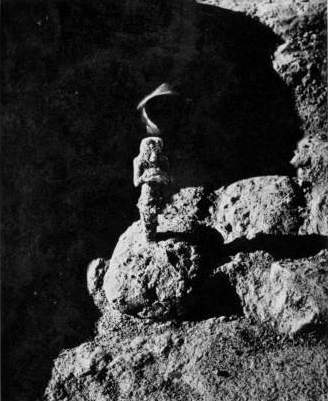 |
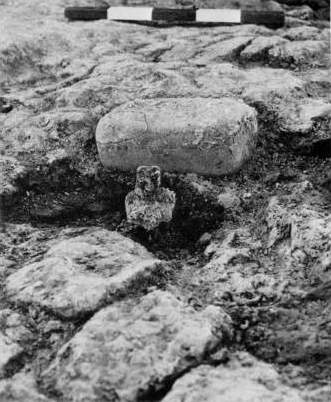 |
Foundation figurine stuck through first
course of brick |
Inscribed stone placed behind the head
of a foundation figurine on top of the third course of brick |
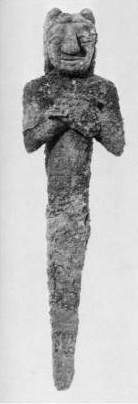 |
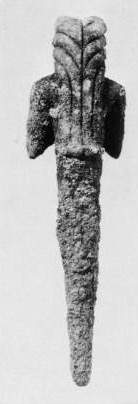 |
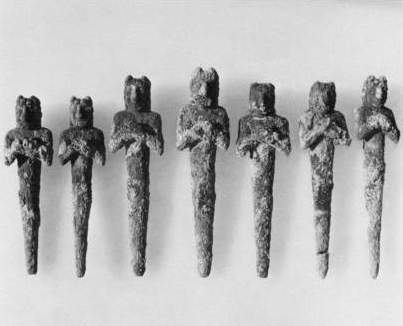 |
Frontview of foundation figurine |
Rear view of foundation figurine |
The seven foundation figurines |
Each of the ten inscription stones found contained the same text which R. Biggs translated as follows:
For Inanna, goddess of all the
lands, Enannatum, the governor
of Lagash,
the one who was chosen in the
heart of (the goddess) Nanshe,
the great governor for (the god)
Ningirsu, the one given a good
name by Inanna, the son
begotten by (the god)
Lugal-...,
the son of Akurgal, the
governor of Lagash, the beloved
brother of Eannatum, the governor
of Lagash- for Inanna he constructed
the temple oval (Ibgal); for her
he made (the temple precinct) Eanna
better (than any other) in all
the lands; he furnished it with
gold and silver; he put (this)
in place so that his god, Shulutula,
might pray forever to
Inanna in the Ibgal for the well being
of Enannatum, the one with whom
Inanna communicates, the governor of
Lagash. The governor who keeps it permanently
in good condition will be my friend.
It emerges therefore that these deposits were placed at the behest of
Enannatum himself, and with the words "he put (this) in place so
that his god, Shulutula..." It becomes apparent that the inscribed
stone identifies the figure in front of it, in each case it is Shulutula,
the personnel god of Enannatum. This was also the personal god of Eannatum
and of Entemena. Further, Hansen relates, these inscriptions conclusively
identify the temple as the Ibgal of Lagash - it was built for Inanna
in the Eanna precinct at Lagash. At this juncture, and to avoid confusion,
it must be clarified that the Ibgal of Inanna in Lagash was not originally
built by Enannatum - it was originally built by his grandfather Ur-Nanshe,
but parts of it were later rebuilt by Enannatum at which time the deposits
were left. (5)
1. "The Sumerians: their history, culture and character" by
S.N. Kramer, 1963.
2. Ancient near Eastern, by Oscar White Muscarella
- The Metropolitan Museum of Art Bulletin
3. Some Light from Ur Touching Lagash, by Ira
M. Price - Journal of the American Oriental Society, 1930
4. Al-Hiba, 1968-1969, a Preliminary Report, by
Donald P. Hansen - Artibus Asiae, 1970
5. Royal Building Activity at Sumerian Lagash in the Early Dynastic
Period, by Donald P. Hansen The Biblical Archaeologist
© 1992